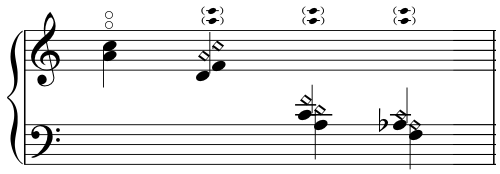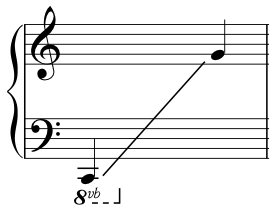Double harmonics
N.B. Double harmonics can only be produced with the left hand.
Production
Two strings are stopped at the middle (or 2/3, 3/4, 4/5) point with the base of the hand and the upper portion is plucked with the thumb and the second or third finger. As the strings are plucked, the hand leaves the strings, letting them resonate.
N.B. It is considerably easier to produce double harmonics when the two strings have the same accidental. The middle (or 2/3, 3/4, 4/5) of the string depends on the pedal position; therefore, the correct harmonic point on the string can vary considerably. If the two strings have a different "middle," it can be hard to produce two clear harmonics with the same hand. In order to do that one has to twist the base of the hand to be able to stop both strings at their exact middle.
Sound
Double harmonics sound the same as their equivalent single harmonics.
Notation
Double harmonics are notated as an interval where they are played. A small circle or diamond is added for each note. Both harmonics should preferably be of the same kind (octave, fifth, double octave, etc.)

Double harmonics with one hand.
Range
The following range is comfortable for playing double harmonics with the left hand:

Comfortable range for double harmonics with one hand.
Intervals
It is possible to play any two-note interval, within a distance of six or seven strings, as a double harmonic.